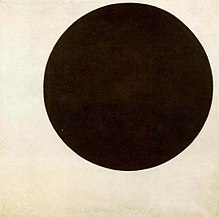Suprematisme (art)

El suprematisme fou una tendència artística ideada i encapçalada pel pintor i teorètic ucraïnès de l'avantguarda soviètica Kazimir Malèvitx,[1] i que sorgí uns anys després del cubisme. En aquesta tendència, els elements formals es reduïxen al triangle, el quadrat, la creu i el cercle; els elements cromàtics es circumscriuen a vermell, negre, blau, blanc i verd. Aquesta tendència defensa un art alliberat de fins pràctiques i estètics, l'abstracció pura, expressada per mitjà de les figures geomètriques, prescindint de l'aparença dels objectes. L'obra del mateix Malèvitx "Quadrat negre sobre blanc", de 1918, en la qual s'ha prescindit completament del color, representà una revolució en l'art.
El nom li fou donat per Malèvitx, teoritzat primer en el manifest de 1915 escrit pel pintor en col·laboració amb el poeta Vladímir Maiakovski, i més tard en el seu assaig de 1920, El suprematisme o el món de la no representació.[2][3]
El suprematisme va tenir una gran influència en pintors com Vassili Kandinski i en la Bauhaus alemanya, i fou seguit per artistes de l'avantguarda soviètica (sovint dita avantguarda russa) com ara El Lissitsky, Olga Rózanova, Oleksandra Ekster, Nina Genke, Liubov Popova, Ksenia Boguslàvskaia, Nadejda Udaltsova, Ivan Kliun, Ivan Puni i Volodýmyr o Vladímir Tàtlin (Володи́мир Та́тлін), que junt amb el Malèvitx, fou la figura més important de l'avantguarda soviètica dels anys 1920. Tot i així, el suprematisme roman lligat essencialment al seu creador, que li imprimeix el seu caràcter particular. A Catalunya seguí aquesta tendència el pintor gironí Joaquim Llucia i Olivet (1929-1973) i ha influït notablement en l'obra d'Enric Ansesa i Gironella.
Referències
[modifica]- ↑ Hatje Gerd. (1980). Diccionario ilustrado de la arquitectura contemporánea. Editorial Gustavo Gili. Barcelona. ISBN 84-252-0860-2
- ↑ Gooding, Mel «Abstract Art». Tate Publishing, 2001.
- ↑ Diccionario de Arte II (en castellà). Barcelona: Biblioteca de Consulta Larousse. Spes Editorial SL (RBA), 2003, p.255. DL M-50.522-2002. ISBN 84-8332-391-5 [Consulta: 8 desembre 2014].
Text is available under the CC BY-SA 4.0 license; additional terms may apply.
Images, videos and audio are available under their respective licenses.
